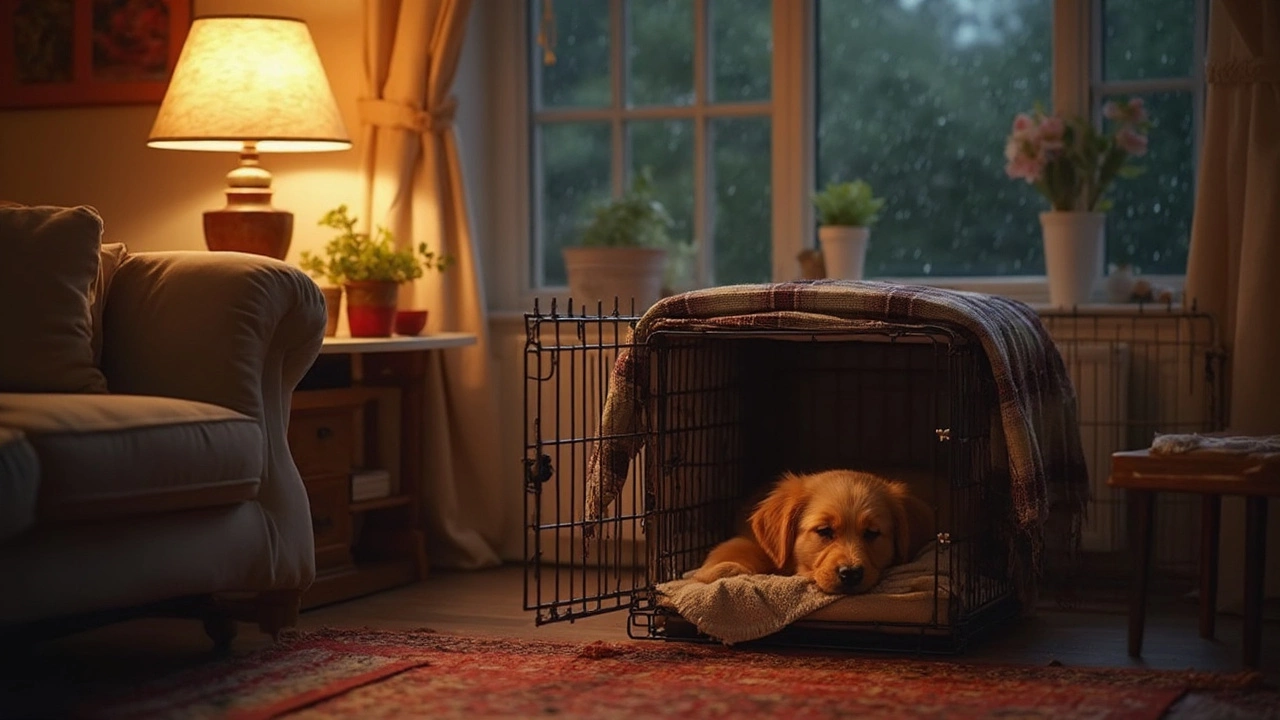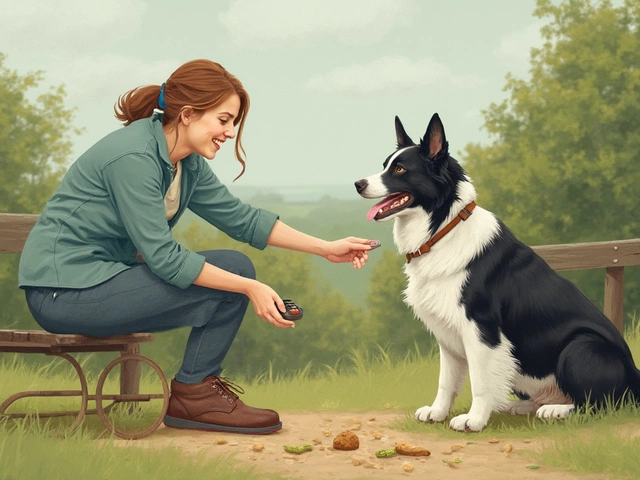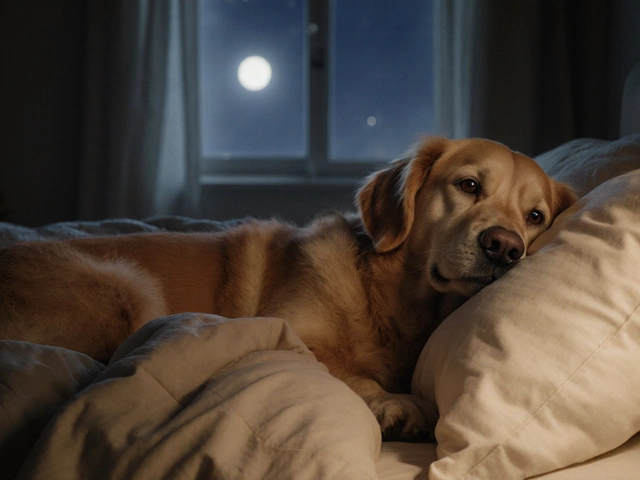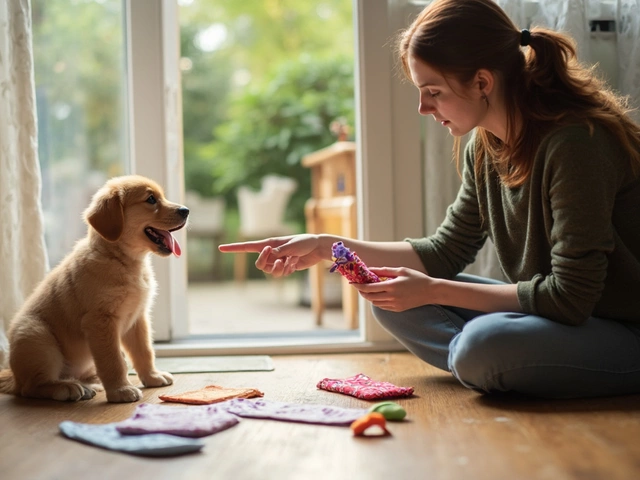If you've ever been eight hours deep in a parenting forum arguing about crate covers, trust me, you’re not alone. Loads of new puppy parents wonder if they should toss a blanket over their puppy’s crate at night—or if that’s just something your cousin’s dog trainer once recommended and everyone copied.
The idea behind covering a crate is simple: it can block out light and distractions, making the crate feel more like a cozy den. Puppies, especially the little ones, sometimes need that extra nudge to help them wind down when the house is noisy or the sun isn’t fully set. But there’s no one-size-fits-all answer, and not every pup is signing up for the “cave life.”
- Why People Cover Puppy Crates
- Pros and Cons of Covering
- How to Know If Your Puppy Likes It
- Crate Cover Safety 101
- Tips for a Better Night (With or Without a Cover)
Why People Cover Puppy Crates
The main reason people cover their puppy’s crate is to help their dog feel safe and chill out. Many puppies fuss when they see lights, movement, or people passing by, especially if your home still feels new and big. Adding a cover can block visual noise and turn the crate into their own little den. Dogs are natural den animals, so covering the crate can make it feel snug and secure—like how they’d burrow in the wild.
Covers also help signal when it’s bedtime. Puppies aren’t born knowing that darkness means sleep, but creating that "nighttime mode" inside the crate can teach them quicker. Some vets and trainers say this can shorten those 2 a.m. whimpers and complaints.
For families living in busy neighborhoods or apartments with hallway lights always flicking on, a crate cover can block sudden brightness and prevent your puppy from waking up every time a neighbor walks past. If you’ve got kids like Elsie running around, a cover can also tell them (and the puppy) it’s quiet time now.
- Puppy crate covers can reduce anxiety by cutting distractions.
- They help cue your pet for sleep and calm periods.
- Crate covers are a go-to for families with babies or noisy homes.
- In cold months, they can even keep warmth in—but keep an eye on air flow.
If you’re someone who likes stats, here’s what a few dog owner surveys show:
| Reason | % Owners Who Used Covers |
|---|---|
| To reduce anxiety | 47% |
| To block light/noise | 31% |
| To help puppy sleep | 19% |
| Other/Not sure | 3% |
Not every puppy needs a cover—some pups might not care, or they could even dislike having their space closed off. But if you’ve got a light sleeper, a cover often becomes one of those parenting hacks that just makes nights go smoother for everyone.
Pros and Cons of Covering
Covering a crate at night is a hot topic for new puppy owners, and there’s plenty to consider before you make it a habit. Some folks swear it helped their puppy sleep through the night after just two days, while other dogs seemed to hate it from the start. Like so many things in puppy care, it’s not completely black-and-white.
- Puppy crate covers can create a dark, cozy feeling that shuts out sights and sounds, signaling to your puppy it’s bedtime. This can be great for dogs who are easily distracted or upset by noises in the house—think laundry machines, TV sound, or kids staying up late. For lots of young pups, dimming their world means fewer excuses to whine at 3 a.m.
- On the flip side, not all puppies like the dark; some might get nervous or more anxious when you tuck them in. Puppies who were just separated from their litter can be spooked if it suddenly feels too isolated.
- Covers can also help with drafts or chilly rooms, especially if your house is extra cold at night. But overdoing it, especially with thick blankets or towels, can make the air stuffy inside the crate and even turn it dangerously hot—something that tiny puppies can’t handle.
- If your puppy’s a chewer, a hanging cover means a new thing to tug, chew, and possibly swallow. Puppies are ridiculously fast at turning fabric into snack-sized pieces. Always choose covers that are safe, secure, and don’t dangle into the inside.
- One thing that surprised me: not every crate material works well with covers. Plastic crates have less airflow than wire ones, so covering these needs extra caution to avoid overheating or stuffy air.
Bottom line? Covering your puppy’s crate at night has its upsides if your dog actually benefits, but it’s not a magic fix and it’s not for every pup. Keep an eye on your dog’s reaction, and always double-check that their space stays comfy—not too hot, cold, or scary.
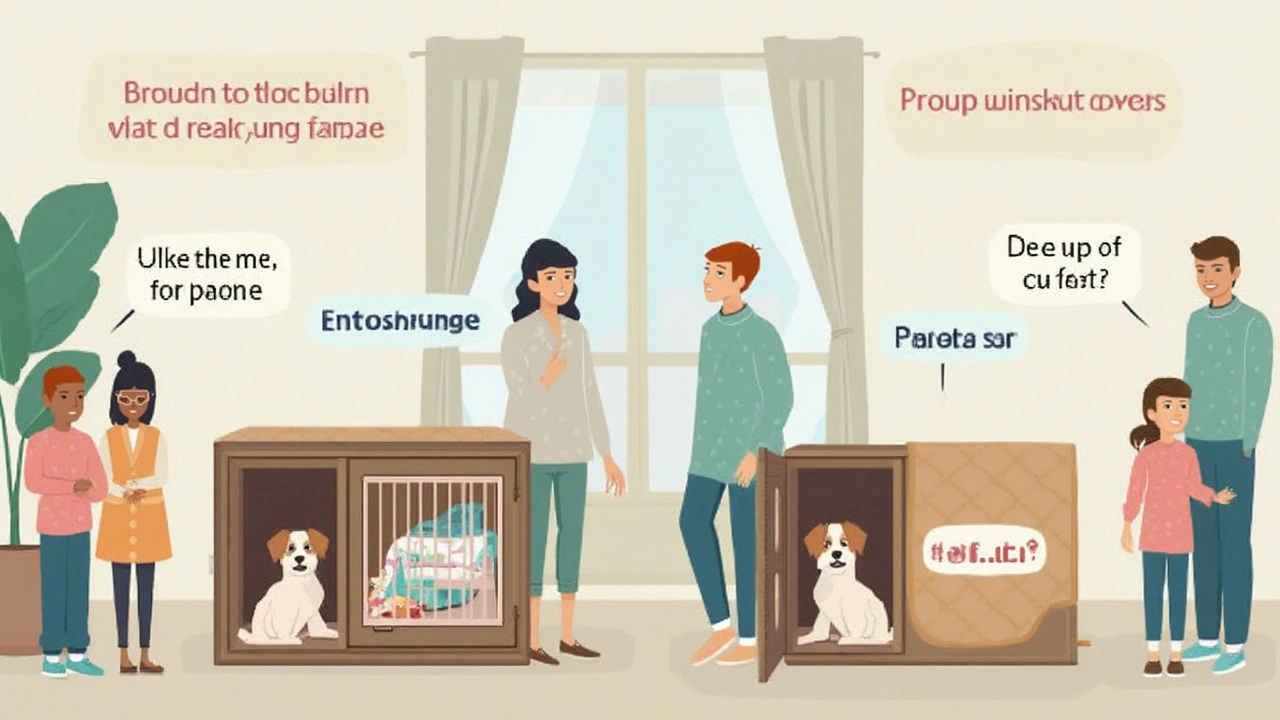
How to Know If Your Puppy Likes It
You don’t have to play detective to figure out if your puppy likes their crate covered. Pups tend to make their feelings pretty obvious. Watch their body language the first few times you cover the crate. Are they relaxed and sleepy, or do they turn into tiny tornadoes trying to push the cover off? That’s your first big clue.
If your puppy settles down faster, stops whining, and doesn’t paw at the crate, those are good signs. On the other hand, if your puppy pants, barks, or scratches more than usual, the cover is probably making them anxious. Some breeds—especially the more curious or anxious ones—just don’t like anything blocking their view.
Try this simple test:
- Cover the puppy crate about 15-30 minutes before bedtime for a few nights in a row.
- Stay close by so you can listen for whining, barking, or scratching.
- Remove the cover for a couple of nights and see if anything changes—look for noise, pacing, or nervous behavior.
- If your pup keeps sleeping soundly both ways, congrats: you’ve got an easygoing dog. If not, go with whatever setup has fewer anxious signs.
Puppy sleep behavior usually gives you the answers. According to a study done at the University of Lincoln, most puppies adjust to crate training within a week, but signs of anxiety (like whining or restless pacing) tend to show up almost immediately if something’s off. Here’s a quick breakdown from actual puppy parents about their experience with crate covers:
| Observation | Puppy Reaction | Next Step |
|---|---|---|
| Settles quickly, sleeps through night | Relaxed, calm | Keep cover on |
| Whining, pawing at cover | Anxious, restless | Try without cover |
| No difference cover/no cover | Adaptable | Use what fits your routine |
If you want to track things closely, jot down what you notice in your phone or a notebook for a few nights. It’s surprisingly helpful, especially if you’re operating on little sleep.
Crate Cover Safety 101
Safety beats style, always. So before you drape anything over your puppy’s crate, let's break down what really matters—no guessing, just facts. Covering a crate can turn it into a snug den, but it’s got to be safe, or it’s not worth the peace and quiet.
- Only use breathable materials for covers, like a light blanket or a commercial crate cover. Anything thick or plastic can trap air and make it hard for your pup to breathe.
- Make sure your puppy can’t pull the cover inside the crate—they’ll chew it, tangle up, or worse. If your pup is Houdini with blankets, skip the cover until they’re older and less bitey.
- Keep at least one side exposed for proper airflow, even with “safe” covers. Full blackout is not only unnecessary, but it can also stress out some puppies.
- Your puppy's crate should never get hot or stuffy. The temperature inside the crate should stay comfortable—think 60-75°F (15-24°C). If you’re unsure, check it with a thermometer before bedtime.
- Wash covers often. Puppies aren’t always the cleanest sleepers, and dirty fabric collects fur, smells, and sometimes germs you don’t want close to your furball.
Puppy crate accidents can happen, but following safety basics keeps things chill. Here’s a quick look at what’s safe and what’s not:
| Material | Safe for Covering? | Why (or Why Not) |
|---|---|---|
| Light Cotton Blanket | Yes | Breathable, easy to wash, no heat trap |
| Towel | Sometimes | Okay if not chewed, can block airflow when damp |
| Plastic Sheet | No | Traps heat, possible suffocation risk |
| Commercial Crate Cover | Yes | Designed for airflow, fitted to crate |
One last thing to know—never leave your puppy unsupervised with a new setup. Test it out with short naps. Some dogs settle down right away, others might paw and chew at the cover (or bark just for fun). Watch for these signs and adjust. It’s your puppy’s bed, but you set the ground rules for safe sleep.
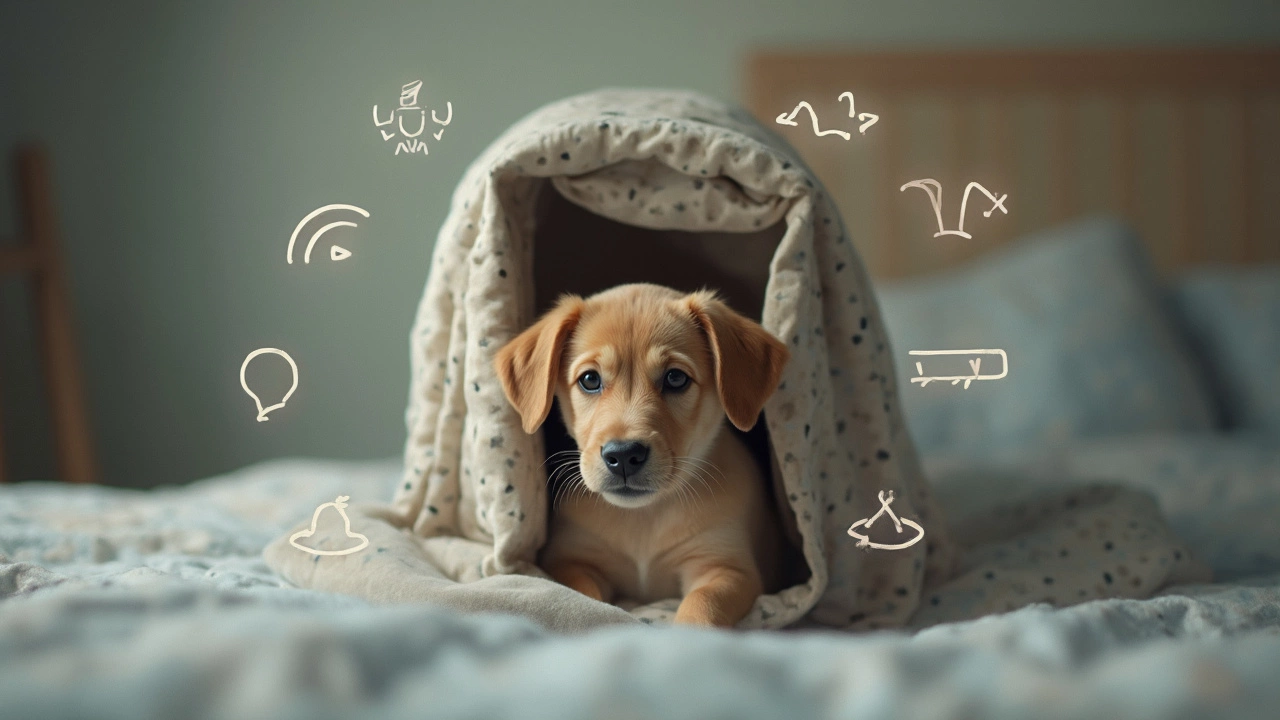
Tips for a Better Night (With or Without a Cover)
The whole goal here is simple: get your puppy (and you) the best sleep possible, whether you use a crate cover or skip it. Let’s break down what actually makes a difference at night.
Start with a solid bedtime routine. Dogs, even little puppies, are big fans of habits. Try to keep walk, potty, and crate time at the same hour every night. This predictability signals their body it’s wind-down time.
If your puppy sleeps in a busy spot, blocking out excess light and noise can help. A cover might do this, but you can also move the crate to a quieter corner. Not every pup likes being shut in darkness though, so watch for signs of stress—like pacing, whining, or chewing. If that happens, skip the cover or leave a side open so air and light get in.
Here’s something lots of new puppy parents miss: the puppy crate should be comfy. Add a soft blanket or pad, but avoid anything fluffy if your puppy is still in that chewing-everything phase. Some breeds run hot and do better with just a towel.
Make sure your puppy’s crate isn’t next to a vent, radiator, or window draft. Puppies can’t regulate their temp as easily as grown dogs. Getting the room temp right—usually around 68°F (20°C) overnight—makes a real difference. Here’s a quick table that shows ideal sleep temps by puppy age:
| Puppy Age | Ideal Nighttime Temp |
|---|---|
| 8-12 weeks | 68-72°F (20-22°C) |
| 3-6 months | 65-70°F (18-21°C) |
| 6+ months | 60-68°F (16-20°C) |
White noise machines, a ticking clock, or even soft music can help mask scary sounds if you live in a noisy area. My daughter Elsie swears our pup’s favorite lullaby is the old Friends theme—who am I to argue with results?
Lastly, don’t forget the basics: late-night potty trips, no food or water an hour before bedtime, and skip the hyped-up play right before they settle down. Calm energy leads to calm sleep.
- Test your puppy’s reaction to a crate cover for a few nights—if sleep gets worse, skip it.
- Double-check for good airflow if you do use a cover.
- Stick with simple bedding if your puppy chews.
- Keep a steady bedtime and morning routine.
- And remember: what works now might change as your puppy grows.
Every puppy is different. Some love the secure “den” feeling, others need to keep tabs on everything (even at 3 am). Follow their cues, use the data, and you’ll both sleep easier—cover or not.
